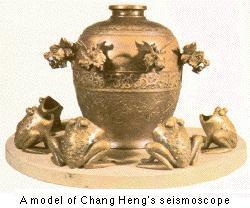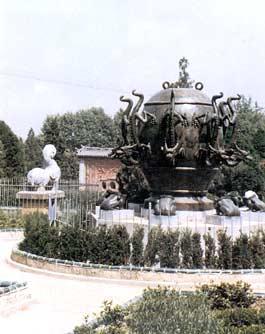 Our knowledge about Chang Heng comes from his biography in The History of the Eastern Han Dynasty.
Our knowledge about Chang Heng comes from his biography in The History of the Eastern Han Dynasty.Mathematician, astronomer and geographer, b. 78 (Nan-yang, China), d. 139.
 Our knowledge about Chang Heng comes from his biography in The History of the Eastern Han Dynasty.
Our knowledge about Chang Heng comes from his biography in The History of the Eastern Han Dynasty.
Chan was noticed for his good writing style when he was 12 years old. At 16 he left home to study in several capital cities. He was interested in literature and produced several works that brought him recognition as a writer.
In his early 30s Chang Heng decided to turn to astronomy. He was soon recognized as a scientist and entered government service at the age of 38. Eventually he became chief astronomer and minister under emperor Liu Yu (An-ti) of the Han dynasty, who reigned from 106 to 125. in 123 Chang introduced a calendar reform, which aligned the months again with the seasons.
Chang's cosmology was based on the concept that earth and the sky are round and the earth is in the centre. In his work Ling Xian he wrote:
To demonstrate his concept, Chang constructed a celestial globe with a water drive ("clepsydra"), which rotated accurately once every day. It was one metre in diameter, was inlaid with 1449 stars and showed the ecliptic and the equator.
 According to his biography Chang wrote 32 papers in science, philosophy and literature. In one poem he described his attitude towards research. Another poem describes how his mind left his body and travelled through space so that it could see the Earth as a sphere.
According to his biography Chang wrote 32 papers in science, philosophy and literature. In one poem he described his attitude towards research. Another poem describes how his mind left his body and travelled through space so that it could see the Earth as a sphere.
Chang Heng's best known invention is a seismograph, or more accurately a seismoscope, since it did not produce a graph of the earthquake but indicated in which direction it occurred, which stood in the imperial capital Louyang. It consisted of a main body in the shape of an urn made of bronze, which carried eight dragon heads. Each head held a copper ball in its mouth. Eight frogs were squatting under each head, ready to catch a ball, should it fall.
Inside the urn was a copper pendulum shaft connected to eight copper rods that connected to the yaws of the dragon heads. During an earthquake the pendulum swang, pushing against one of the rods and opening the corresponding dragon's mouth. The fall of the ball into the frog's mouth was loud enough to alert people from the imperial court even at night.
The diagrams below (Wang Zhendu, 1938) show the principle. The History of the Eastern Han Dynasty records that in February of the year 138 the dragon facing west had dropped its copper ball and it was reported to the emperor that an earthquake had happened somewhere to the west of the capital. Since nothing had been felt in the capital Chang Heng was accused of fraud. Two days later horsemen arrived and reported that a violent earthquake about 500 km to the west had caused severe landslides. Chang's seismoscope was evidently sensitive enough to record the earthquake.

The original seismoscope, which was about 2.4 m in diameter, does not exist any more. A full scale replica, seen below, was constructed by Wang Zhendu in 1951.

Wang Zhendu (1938) The imaginal seismoscope by Zhang Heng. Journal of Yanjing 22 no. 20 (in Chinese).